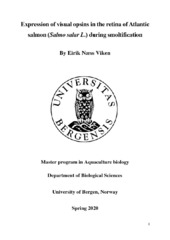| dc.description.abstract | Abstract: The visual system of Atlantic salmon is highly adapted to their migratory and dynamic life-history, where the profound transformational process of smoltification is crucial. The retina contain both rod- and cone photoreceptors that express specific classes of opsins. Rhodopsin expressed in rod photoreceptors is responsible for the detection of light in dimmed conditions (scotopic vision). Cone photoreceptors, responsible for the detection of light in bright, coloured conditions (photopic vision), consist of the single cones: The first short wavelength-sensitive sws1 (UV opsin) and the second short wavelength-sensitive sws2 (blue opsin), and the double cones: the middle wavelength-sensitive rh2 (green opsin) and the long-to-middle wavelength-sensitive lws (red opsin). The main purpose of this study was to establish the topographic distribution of the various photoreceptor classes (opsins) using the In situ hybridization (ISH) method on cryosections, during a period where the Atlantic salmon developed from a parr, through the smoltification process, and towards having spent a month in sea water. It was shown that patterns were different between the cone opsins, especially by comparing expression in genes related to single- and double cones. Additionally, comparisons were made between the distribution of the rod- and cone photoreceptor classes, where the constant prominent presence of rhodopsin was likely influenced by the continuous incorporation of rod photoreceptors through neurogenesis in rod precursor cells in the outer nuclear layer (ONL). This continuous supply of rhodopsin throughout the expanding retina is a consequence of the post-embryonic development common to teleosts. In addition, retinal alterations was observed through the smoltification process, especially in the downregulation of sws1. The commonly presented causation of this transformation is a process called opsin changeover, where sws1 is proposed to be transformed into sws2 during the alevin stage. However, findings in the literature on Atlantic salmon in addition to the fluctuating pattern of sws2 observed in this study questioned the influence of this theory in salmon. Sws2 displayed a central prominence adjacent to the optic nerve on the central eye section during the smolt stage, a finding previously unknown in Atlantic salmon, potentially illustrating the continued importance of the embryonic fissure in single cone generation. The importance of the ciliary marginal zone (CMZ) in the generation of cone photoreceptors was demonstrated in the continuous prominence of sws2, rh2 and lws adjacent to this area through smoltification. However, the reduced presence of sws1 in this area opposed the theory stating that the appearance of cone opsins in the CMZ would be reflected through the retinal transformation. The topographic distribution and its dynamic patterns in the retina were put into an ecological perspective, demonstrating how the migration from fresh water to salt water has functioned as a natural influencer on the observations made. Additionally, the findings of this study could support the aquaculture industry in their utilization of lighting conditions exposed to the reared salmon. | en_US |
